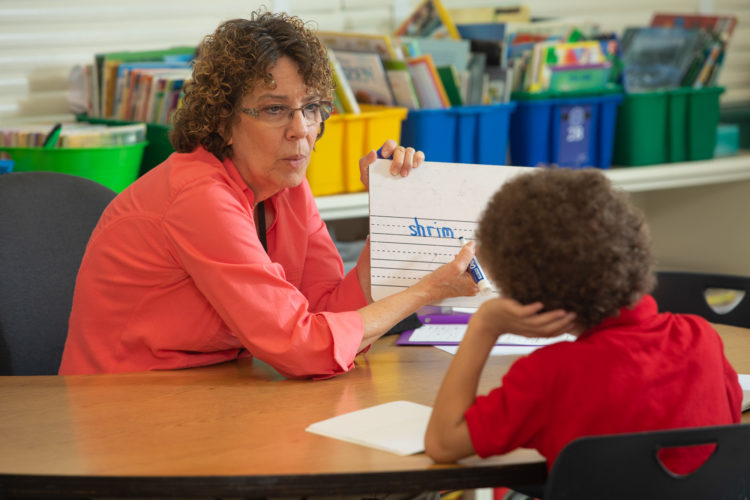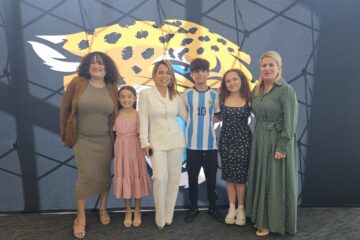Oct. 29, 2020 – Entering GRASP Academy on Justina Road is like entering any other school in Northeast Florida…but with one main difference.
Each student at this academy demonstrates characteristics of dyslexia.
The International Dyslexia Association defines dyslexia as a neurobiological learning disorder that is characterized by “difficulties with accurate and/or fluent word recognition and by poor spelling and decoding abilities.”
These difficulties – estimated to exist in one in five children – are something GRASP Academy staff embrace.
“Dyslexia is not a disease,” said Principal Annessia Powell. “It is a learning disability. And like all learning disabilities, students can find success in and out of the classroom the correct support and interventions.”
These interventions include creating emotionally-sound environments, using an explicated, multi-sensory approach to instruction, using small groups, allowing students to “wiggle” and move around, and incorporating assistive technology into everyday learning.
“It’s ok to mess up”
It is not uncommon for children with dyslexia and related disabilities to fear school, said physical education teacher Keaton Spillman.
“I have dyslexia, so I know a lot about what these children are going through,” said Spillman, who is the school’s 2020 teacher of the year. “In high school, I was always scared that my teachers were going to judge my spelling very negatively. Something I did to cope with that was I wrote very, very tiny. I would write just big enough so that they could see the answer was correct, but not see how I spelled it.”
Spillman says he recognizes these coping mechanisms in many of his students who he says have experienced “failure” previously in school. It’s why he works with his fellow GRASP educators to create an emotionally sound environment with an emphasis on building trust.
Strategies include: rehearsing and preparing for classroom discussions during lunch or before class; starting instruction with specific, open-ended questions rather than closed-ended questions so students will get a correct answer no matter what, and educators collaborate and use the same strategies so that students get to practice the strategy in all their classes.
Additionally, Powell said the first few weeks of school are spent building relationships with students and reassuring them it is ok to make mistakes and embrace student’s differences.
“We work really hard to create an environment where our students know that its ok to mess up,” Powell said. “It’s ok to make a mistake. And we model for that students. I have watched teachers share with students how they struggle to pronounce particular words.”
Multi-sensory approach
A visit to Kristi Orchard’s third grade classroom will find her students “finger tapping.” This is a method used to separate and identify the distinct sounds in words.
This method incorporated saying the sound (auditory), tapping their finger on their desk to represent each sound (tactile) and spelling the word out with alphabet blocks in front of them (visual and tactile).
Engaging all the senses are an important part of how children with dyslexia learn.
“These are super-smart children that just happen to learn differently,” said Powell. “So, our staff use a multisensory, explicit approach so that all students have opportunities to be successful. You go to an elementary classroom and see teachers doing auditory drills where students are air tracing letters while saying each letter sound and key word. We have syllable types springing from the walls with students using them to read grade-level text. Speech to text is just like pencil and paper, and color coding helps keep teachers and students organized so they can follow a map.”
“The same standard, a different way”
“We’re just antsy,” said fourth-grade educator, Antionette Chatman.
Like many of her students, Chatman says she has ADHD, a condition that many times overlaps with dyslexia. For this reason, it is important to incorporate a lot of movement and interactivity in the classroom.
“We’re constantly moving,” said Chatman. “We’re wiggling around, we’re singing, and we’re using pneumonic devices. When we’re studying geography, they have a map at their seat but there is also a big one on the wall where they can get up and point to the different geographic points we’re discussing and then go back and draw it on their paper.”
GRASP students, said Powell, are learning the same standards as their peers, but need to incorporate methods such as movement to help them succeed.
“Teachers understand that a student may need to stand and even wiggle to produce their best work or just to pay attention,” said Powell.
Ultimately, educators strive to recognize and meet the diverse learning needs of their students.
“The sky is the limit,” said Powell. “And they are encouraged to reach for it.”
GRASP Academy serves students first through eighth grades and is the only public school in Northeast Florida that specializes in instruction for students with dyslexia and related learning disabilities such as dyscalculia and dysgraphia.








